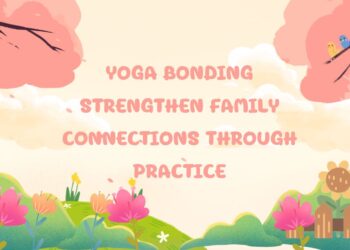Practicing yoga with your child is a wonderful way to strengthen your bond, improve communication, and share a fun, healthy activity together. Partner yoga poses are specifically designed to be done in pairs, making them perfect for parents and kids. These poses not only enhance flexibility and balance but also encourage teamwork and trust. Whether you’re new to yoga or looking to add a new dimension to your practice, here are five partner yoga poses that parents and kids can enjoy together.
1. Double Downward-Facing Dog (Adho Mukha Svanasana)
Double Downward-Facing Dog is a playful twist on the traditional Downward Dog pose. It’s a great way to stretch the entire body while having fun together.
- How to Do It:
- Parent: Start in Downward-Facing Dog with your hands and feet on the ground, forming an inverted “V” shape with your body.
- Child: Stand facing your parent and place your hands on their lower back or hips. Walk your feet back until you can lift your hips and place your own body into a Downward Dog position, creating a smaller inverted “V” shape above your parent.
- Both: Hold the pose for a few breaths, feeling the stretch in your hamstrings, shoulders, and back. Then, carefully release and switch positions if you like.
This pose encourages balance and coordination while also allowing you to connect physically and energetically with your child.
2. Seated Forward Bend and Backbend (Paschimottanasana and Purvottanasana)
This partner pose combines a forward bend for one person with a backbend for the other, creating a dynamic stretch that benefits both partners.
- How to Do It:
- Parent: Sit on the floor with your legs extended straight in front of you, feet flexed. Begin by folding forward into a Seated Forward Bend, reaching for your toes or shins.
- Child: Sit facing away from your parent, with your back touching theirs. Place your hands on the ground behind you and lift your hips into a Backbend (Purvottanasana), creating a bridge over your parent’s back.
- Both: Hold the pose for several breaths, feeling the stretch in your back, legs, and chest. Gently release and switch roles if desired.
This pose is great for building trust and understanding between parent and child, as each partner supports the other in different ways.
3. Partner Tree Pose (Vrksasana)
Partner Tree Pose is a fun way to practice balance and focus together. It’s a simple pose that’s easy to learn but offers a challenge when done in pairs.
- How to Do It:
- Both: Stand side by side with your feet hip-width apart. Shift your weight onto your inside leg (the leg closest to your partner) and bring the sole of your outside foot to rest on your inner thigh or calf, avoiding the knee.
- Both: Press your palms together at your chest and lean gently towards each other, using your partner for support. You can also hold hands if that feels more comfortable.
- Both: Hold the pose for a few breaths, focusing on a point in front of you to maintain balance. Switch sides and repeat.
This pose helps improve balance and coordination while fostering a sense of unity and teamwork between parent and child.
4. Double Boat Pose (Navasana)
Double Boat Pose is a core-strengthening pose that’s both challenging and fun. It requires coordination and cooperation, making it a great way to connect with your child.
- How to Do It:
- Both: Sit facing each other with your knees bent and feet flat on the floor. Hold each other’s hands or wrists.
- Both: Lift your feet off the ground and press the soles of your feet together, balancing on your sit bones. Gradually straighten your legs to form a “V” shape with your bodies, resembling a boat.
- Both: Hold the pose for several breaths, engaging your core muscles and keeping your back straight. Release gently and lower your legs.
This pose builds strength in the core and legs while encouraging laughter and play as you try to balance together.
5. Partner Bridge Pose (Setu Bandhasana)
Partner Bridge Pose is a gentle backbend that helps open the chest and strengthen the back. It’s a great way to end your partner yoga session on a relaxing note.
- How to Do It:
- Parent: Lie on your back with your knees bent and feet flat on the floor, hip-width apart. Lift your hips into Bridge Pose, pressing your feet and shoulders into the ground.
- Child: Sit or lie down on top of your parent’s hips or abdomen, depending on their size and comfort level. Place your hands on the ground for support if needed.
- Both: Hold the pose for a few breaths, feeling the stretch in your back and chest. Gently lower your hips back to the ground to release.
This pose allows for gentle stretching and relaxation while providing a soothing, calming connection between parent and child.
Conclusion
Partner yoga is a fantastic way for parents and kids to bond, have fun, and stay active together. These five poses are easy to learn and offer a mix of stretching, balance, and strength-building that benefits both partners. Whether you’re practicing at home or in a class, partner yoga encourages communication, trust, and mutual support. Most importantly, it’s a great way to share the joy of yoga with your child, creating memories that will last a lifetime.












